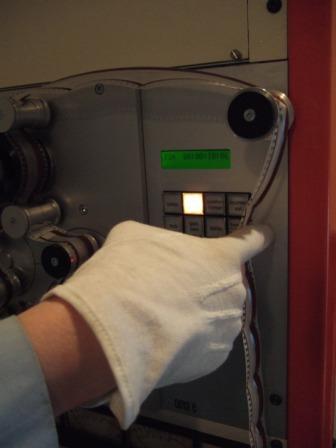Getting to Know Harry Truman
This week’s guest blogger is Heidi Holmstrom. Heidi works in the Motion Picture Preservation Lab, which is responsible for performing conservation and preservation work on motion picture records held across the National Archives.
I’ve gotten to know President Harry Truman pretty well over the past year. I’m familiar with his opinions, mannerisms, and vocal cadence. In some ways, he reminds me of my grandfather.
 How did I become so well-acquainted with our 33rd president? I’ve never met him and I’m no presidential historian, but I do work in the Motion Picture Preservation Lab at the National Archives and Records Administration.
How did I become so well-acquainted with our 33rd president? I’ve never met him and I’m no presidential historian, but I do work in the Motion Picture Preservation Lab at the National Archives and Records Administration.
We are currently working on a very big project for the Harry S. Truman Library and Museum to preserve and create access copies for their Screen Gems collection. This collection consists of the outtakes from a 26-part television documentary featuring President Truman that aired in 1964.
The Truman Library sent us a great deal of material needing preservation, both images and sound. Many of the picture and sound elements are suffering from vinegar syndrome, in which the cellulose acetate of the film base breaks down into acetic acid, which accelerates physical deterioration. Holding so much of this material in my room means that my workspace always smells like vinegar!
Other than the vinegar syndrome, the picture elements are in good shape and can be printed easily to new polyester film stock. When stored correctly, these new reels can last for more than 500 years.
The magnetic soundtracks are more problematic. While the majority have few issues beyond vinegar syndrome, others have shrunken so much that they won’t run through standard equipment. When unspooled, these films tend to curl up, making them difficult to work with.

The base sheds so much plasticizer that it builds up like snow on our machines.

Working with highly deteriorated material is as much an art as it is a science. Understanding the Standard Operating Procedure for our sound recording equipment helps you to choose the correct archival sound head and sprocket wheel, but even when the set-up is optimized, things can still go wrong.
While capturing the audio from the worst of the soundtracks, I watched helplessly as the film moved a distance of only a few feet between two rollers and took that opportunity to curl up, breaking the film and stopping playback.
Each time this happened, I spent an hour or two carefully repairing the tear with tape.

Finally, after the third tear, I discovered that by using my finger as a third roller just at the point where the curling began I could prevent a catastrophic failure.

Using our Digital Audio Workstation, we digitally spliced together the files created from each of my capture attempts and created a single WAV file that matches the audio on the magnetic soundtrack. The next step was to use a machine that writes information with a laser to print new optical soundtracks onto polyester film stock. I did this for all of the material I captured from the original soundtracks, including the highly deteriorated ones.
Now, in addition to the WAV files, we are able to give the Truman library soundtrack copies that, like the preserved picture elements, will last for over 500 years.

New optical soundtrack
You can listen to a sample of the new soundtrack here:
Working on a big preservation project like this is exciting because it forces us to exercise all of our conservation and preservation skills. Here in the Motion Picture Preservation Lab, we are proud of our role in helping NARA ensure that the government’s motion picture records will be accessible to the American people for generations to come!
Comments
Matthew November 10, 2012 at 9:03 pm
Hello, just wanted to say, I loved this article. It was inspiring.
Keep on posting!
Matthew

Carrie Goeringer August 10, 2012 at 11:02 am
Great work Heidi, thanks for persevering on such a tricky assignment and coming up with an innovative way to complete it.